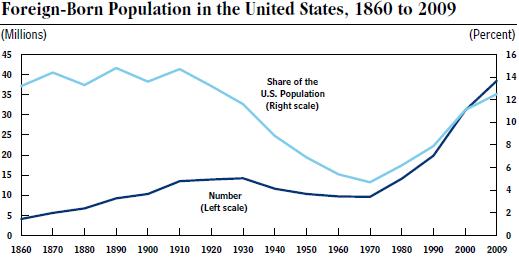CBO: foreign-born percentage highest in 90 years; 25% non-citizens in poverty; 38% foreign born from Latin America; fewer women work than native-born
The Congressional Budget Office has released "A Description of the Immigrant Population" (PDF link, cached), showing, among many other things, that the percentage of foreign-born people living in the U.S. is now at its highest since 1920; see the chart attached below. Per the CBO, as of 2009 there were about 39 million foreign-born people living in the U.S.; of that number, 17 million were naturalized citizens and about 10.8 million were illegal aliens.
CBO director Douglas Elmendorf offers a summary (cboblog.cbo.gov/?p=2248):
* In 2009, about 38 percent of foreign-born people in the United States were from Mexico or Central America; the next-largest group came from Asia and accounted for 27 percent of the total foreign-born population.
* About one-fifth of naturalized U.S. citizens were from Mexico or Central America; more than one-third were from Asia. About half of the noncitizens living in the United States in 2009 were from Mexico or Central America, and about one-fifth were from Asia. An estimated 62 percent of noncitizens unauthorized to live in the United States were from Mexico.
* From 2000 to 2009, more than 10 million people were granted legal permanent resident (LPR) status in the United States. Legal permanent residents are permitted to live, work, and study in the United States. Over the past two centuries, the main areas of origin of legal permanent residents in the United States have changed from primarily Europe and Canada to Asia, Mexico, and Central America.
* In 2009, more than 1 in 4 people in California and more than 1 in 5 people in New York and New Jersey were born in another country. Conversely, in 31 states, fewer than 1 person in 20 was foreign born. The foreign-born share of the population increased in all but three states between 1999 and 2009.
* The four states with the highest concentrations of unauthorized residents in 2009 were Nevada, California, Texas, and Arizona. Almost half of all unauthorized residents of the United States were living in those states.
* Compared with the native-born population, relatively few foreign-born people are under the age of 25. In 2009, only 15 percent of the foreign-born population was under that age, compared with 37 percent of the native-born population. In contrast, nearly three-quarters of the foreign-born population was of working age (between 25 and 64 years old), compared with about half of the native-born population.
* Marriage and fertility rates are generally higher among young foreign-born women than among their native-born counterparts.
* In 2009, 29 percent of the foreign-born population between the ages of 25 and 64 had not completed high school, compared with 8 percent of the native-born population. Some groups of foreign-born people, however, had more education than did their native-born counterparts. About 55 percent of people from Asia had at least a bachelor’s degree, as did 47 percent of people from Europe and Canada; just 32 percent of the native born population had earned at least a bachelor’s degree.
From the report, note also these:
Noncitizens tended to live in families with much lower family income than native-born or naturalized citizens and, as a consequence, were more likely to have family income below the poverty threshold (about $22,000 for a family of four in 2009). In 2009, 25 percent of noncitizens lived in poverty, compared with 11 percent of naturalized citizens and 14 percent of native-born people.
Marriage and fertility rates are generally higher among young foreign-born women than among their native-born counterparts. In 2009, 20 percent of foreign-born women ages 15 to 24 were (or had been) married, compared with 9 percent of native-born women; 68 percent of foreign-born women ages 25 to 34 were (or had been) married, compared with 57 percent of native-born women. The fertility rate (the expected number of births) among foreign-born women between the ages of 15 and 49 was 2.6, compared with a fertility rate of 2.0 for native-born women in the same age range.
Foreign-born men are more likely to be working or looking for work (that is, to be in the labor force) than are native-born men. Foreign-born women, however, are less likely than native-born women to be in the labor force. In 2009, 93 percent of men ages 25 to 64 from Mexico and Central America were in the labor force, compared with 88 percent of men from Asia and 85 percent of native-born men. Conversely, 57 percent of women in that age group from Mexico and Central America were in the labor force in 2009, as were 67 percent of Asian women, both significantly below the 74 percent of native-born women in the labor force in that year.



